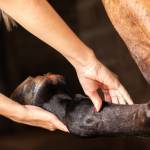IRAP, Stem Cells Fail to Rescue Injured Tendons in Horses

Despite the frequency of tendon injuries in athletic horses, therapies that permit functional healing with low rates of reinjury elude the industry. Stem cells and other regenerative therapies, such as interleukin-1 receptor agonist protein (IRAP), are being used more frequently to manage tendon injuries; however, a study reported that these therapies cannot rescue injured tendons from damaging inflammatory mediators.*
Injured tendons require a moderate level of inflammation to initiate healing, but prolonged, unresolved inflammation may contribute to the production of scar tissue. This scar tissue, known also as fibrosis, is not as strong as normal tendon tissue, which explains why horses with tendon damage are prone to reinjury.
The pro-inflammatory molecule interleukin (IL) 1-β impairs tendon healing in three-dimensional cell culture models. As expected, IRAP rescued three-dimensional tendon cultures from the adverse consequences of IL-1β because IRAP binds to and essentially deactivates IL-1β, decreasing inflammation.
“But there are many inflammatory mediators present in an injured tendon beyond IL-1β, which means that IRAP may not be sufficient for controlling tendon inflammation completely,” explained Kathleen Crandell, Ph.D., a Kentucky Equine Research nutritionist.
To delve deeper into this, researchers incubated tendon cell cultures with a combination of three pro-inflammatory mediators: IL-1β, tumor necrosis factors-α, and interferon-γ. The inflammatory responses by the cultured tendon cells were then measured and compared to the inflammation measured in cultures that were treated with either IRAP or “bone marrow-derived mesenchymal stem cells conditioned media.” This media was believed to contain soluble anti-inflammatory factors produced by stem cells that would normally be produced by the stem cells if they were injected directly into an injured tendon in a live horse.
“The researchers found that the combination of three pro-inflammatory mediators worked synergistically, inducing greater detrimental consequences for the cultured tendon cells than when used individually,” Crandell said. Those detrimental consequences were not improved by either IRAP or the stem cell conditioned media.
“The fact that IRAP alone did not rescue tendon cells from the detrimental effects of the inflammatory mediators was not altogether surprising because IRAP only blocks the effects of IL-1β,” Crandell explained.
However, the fact that even the stem cell conditioned media did not rescue the tendons from pro-inflammatory mediator damage suggests that perhaps additional inflammatory pathways are involved in tendon injury and inflammation.
The researchers therefore proposed that a “superior approach for treatment of tendinopathy” may involve targeting novel specific signaling pathways rather than simply blocking the standard array of pro-inflammatory mediators.
Regardless of how a horse’s tendon injury is treated by the veterinarian, these injured athletes commonly require prolonged lay-ups.
“Bone loss occurs in laid-up horses due to reduced movement and concussive forces on the bone. Kentucky Equine Research has formulated bone health supplements designed to help prevent bone loss, including instances when horses are on stall rest for prolonged convalescence,” Crandell shared.
*Smith E.J., R.E. Beaumont, A. McClellan, C. Sze, E. Palomino Lago, L. Hazelgrove, J. Dudhia, R.K.W. Smith, and D.J. Guest. 2022. Tumour necrosis factor alpha, interleukin 1 beta and interferon gamma have detrimental effects on equine tenocytes that cannot be rescued by IL-1RA or mesenchymal stromal cell-derived factors. Cell and Tissue Research. doi:10.1007/s00441-022-03726-6.








